French–German enmity

French–German (Franco-German) enmity[1] (French: Rivalité franco-allemande German: Deutsch–französische Erbfeindschaft) was the idea of unavoidably hostile relations and mutual revanchism between Germans and French people that arose in the 16th century and became popular with the Franco–Prussian War of 1870–1871. It was an important factor in the unification of Germany and World War I, and was finally overcome after World War II, when under the influence of the Cold War cordial French–German relations became the key to European integration.
Supposed origins
The rivalry and cultural differences between Gauls and Germans – the pre-Roman cultures that gradually evolved into France and Germany – were noted by Julius Caesar in his On The Gallic War.
Romans, Carthaginians and many other cultures frequently employed Gaul tribesmen as guides and translators. The Gauls frequently raided Roman territory, most spectacularly in 390/387 BC (390 BC being the traditional and 387 BC a probable year), seizing Rome itself after the Battle of the Allia and accepting a sizeable ransom for the release of the city. Gaul itself had strategic importance both because of its geographic position as well as a source of revenue, mercenaries and slaves.
The Germanic tribes, by contrast, remained more isolated and fractious. Germany lay farther from the Roman domain and was well-protected by the strong natural barriers of the Alps, the Rhine and Danube rivers, and the dense forests. Therefore, the expanding Roman Empire turned its attentions to Gaul first, culminating in Julius Caesar's conquest of Gaul in 50 BC.
Because of its closer proximity to Rome and less formidable geographic obstacles, Rome was able to consolidate its control of Gaul. For the next three centuries, until the Crisis of the Third Century, Gaul was an integral part of the Roman Empire. Gaul gradually became Romanized, its people adopting Roman customs and melding their own indigenous tongues with Latin to produce Old French, which through the Middle Ages evolved into French.
Germany, on the other hand, was never fully Romanized. Western Germany, known to the Romans as Germania, was not integrated into the Empire until the 1st century AD, and the Romans gave up trying to conquer and Romanize the eastern half of Germany after the disastrous Battle of Teutoburg Forest.
Cultural differences between the Gauls and Germans conspired with the dramatically different extent of Romanization to establish the two cultures as distinct and discrete entities during the late Roman Empire and early Middle Ages. The Franks, themselves a Germanic tribe, abandoned much of the linguistic and cultural legacy of their Germanic forbears after having conquered Gaul and in time became distinct from other Germanic tribes east of the Rhine.
The Carolingian Empire established in 800 by Charlemagne achieved a transitory political unity, but the death of Charlemagne's son Louis the Pious marked its demise, as in 843 the Carolingian realm was divided into three parts by the Treaty of Verdun. Short-lived Middle Francia, the weak central part under Emperor Lothair I, was soon split again. Its northern Lotharingia part on both sides of the language border became a bone of contention between the western and eastern kingdoms that developed into the modern nations of France and Germany.
France maintained a much more outward-looking geopolitical role through the Middle Ages, fighting wars against the Spanish and British that ultimately defined the nation's identity as a politically integrated and discrete unit, and occupying an important role as Europe's largest, most powerful and most populous Christian nation. For these reasons, French gradually supplanted Latin as the common language of international diplomacy and culture. Germany, on the other hand, remained more inward-looking.
The rapid ascent of Prussia and later Germany during the 19th and the early 20th centuries altered the balance of power between the two nations. This gave rise to an existential change in the nature of their relationship, increasingly defined by mutually hostile modern nationalism. Writers, historians and politicians in both countries tended to project their enmity backwards, regarded all history as a single, coherent and unbroken narrative of ongoing conflict, and reinterpreted the earlier history to fit into the concept of a "hereditary enmity".
France and Habsburg
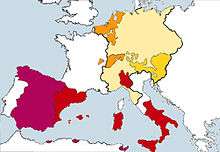
In 1477, the Habsburg archduke Maximilian I of Austria, son of Emperor Frederick III, married Mary the Rich, the only child of the Burgundian duke Charles the Bold. Frederick and Charles had arranged the marriage, shortly before the duke was killed at the Battle of Nancy.
His ancestors of the French House of Valois-Burgundy over the centuries had acquired a collection of territories on both sides of the border of France with the Holy Roman Empire. It stretched from Burgundy proper in the south to the Low Countries in the north, somewhat resembling of early medieval Middle Francia. Upon the duke's death, King Louis XI of France attempted to seize his heritage as reverted fiefs but was defeated by Maximilian, who by the 1482 Treaty of Senlis annexed the Burgundian territories, including Flanders as well as French-speaking Artois and asserted the possession of the County of Burgundy (Franche-Comté).
Maximilian, Holy Roman Emperor from 1493, was also able to marry his son Philip the Handsome to Joanna of Castile, heiress to both the Crown of Castile and the Crown of Aragon. His grandson, Emperor Charles V, inherited the Low Countries and the Franche-Comté in 1506; when he by his mother also inherited Spain in 1516, France was surrounded by Habsburg territories and felt under pressure. The resulting tension between the two powers caused a number of conflicts, such as the Italian Wars or the War of the Spanish Succession, until the Diplomatic Revolution of 1756 made them allies against Prussia.
The Thirty Years War (1618–1648), was a complex conflict that took place in and around the Holy Roman empire, with religious, structural, and dynastic causes. France intervened in this conflict both indirectly, largely but not exclusively, on the side of various intervening Protestant powers, as well as directly from 1635 on. The 1648 Peace of Westphalia gave France limited control over Alsace and Lorraine. The 1679 Treaties of Nijmegen consolidated this result by bringing the towns under French control. In 1681, France occupied Strasbourg.
Meanwhile, the expanding Muslim Ottoman Empire became a serious threat to Christian Austria. The Vatican initiated a so-called Holy League against the "hereditary enemy" of Christian Europe ("Erbfeind christlichen Namens"). Far from joining or supporting the common effort of Austria, Germany and Poland, France under Louis XIV of France invaded the Spanish Netherlands in September 1683, a few days before the Battle of Vienna. While Austria was occupied with the Great Turkish War (1683–1699), France initiated the War of the Grand Alliance (1688–1697). The attempt to conquer large parts of southern Germany ultimately failed, when German troops were withdrawn from the Ottoman border and moved to the region. However, following a scorched earth policy that caused a large public outcry at the time, French troops, under notorious General Ezéchiel du Mas, Comte de Mélac, devastated large parts of the Palatinate, Baden and Württemberg burning down and levelling numerous cities and towns in southern Germany.
In the course of the Seven Years' War and in view of the rising Kingdom of Prussia, which had concluded the neutrality Treaty of Westminster with the British Empire, the French under King Louis XV realigned their foreign policy. The Diplomatic Revolution instigated by the Austrian chancellor Wenzel Anton Kaunitz in 1756 ended the French-Habsburg enmity.
France and Prussia
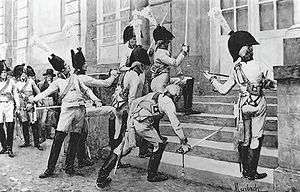
The Diplomatic Revolution as an alliance between France, the Habsburg Empire and Russia manifested in 1756 in the Treaty of Versailles and the following Seven Years' War against Prussia and Great Britain. Although an overall German nation-state was on the horizon, the loyalties of the German population were primarily with smaller states. The French war against Prussia was justified through its role as guarantor of the 1648 Peace of Westphalia, and France was fighting on the side of the majority of German states.
The civil population still regarded war as a conflict between their authorities and distinguished between troops less according to the side on which they fought than according to how they treated the local population. The personal contacts and mutual respect between French and Prussian officers did not stop entirely while they were fighting each other, and the war resulted in a great deal of cultural exchange between French occupiers and German population.
The perception of war began to change after the French Revolution. The levée en masse for the Revolutionary Wars and the beginning formation of nation states in Europe made war increasingly a conflict between peoples rather than a conflict between authorities carried out on the backs of their subjects.
At the battle of Austerlitz (1805), Napoleon I put an end to the millennium-old Holy Roman Empire the next year. A year later, at the battle of Jena, French forces crushed the Prussian armies. Within two weeks of Jena, Napoleon had conquered almost all of Prussia except the area around Königsberg. The Prussian army, previously thought invincible, had been fought to almost the point of total liquidation. This humiliation led German philosophers (such as Clausewitz, Fichte, Arndt...) to play an important role for the development of German nationalism. It led politicians (such as Stein and Hardenberg) to reform Prussia in order to adapt their country to the new world brought about by the French Revolution.
The Continental System, led Napoleon to directly incorporate German-speaking areas such as Hamburg into his First French Empire. Napoleon reshaped the map of Germany by the creation of the Confederation of the Rhine, which included vassal States ruled directly by members of the Bonaparte family (such as the Kingdom of Westphalia, and the Grand Duchy of Berg) and allied States who took advantage of the French protectorate to increase their territory and power (such as the Kingdom of Bavaria and the Kingdom of Saxony).
The Napoleonic Wars, often fought in Germany and with Germans on both sides, as in the Battle of the Nations at Leipzig, also marked the beginning of what was explicitly called French–German hereditary enmity. Modern German nationalism was born in opposition to French domination under Napoleon. In the recasting of the map of Europe after Napoleon's defeat, most of the German-speaking territories in the Rhineland adjoining France were put under the rule of Prussia and remainder of ones were ruled by Bavaria and Grand Duchy of Hesse.
Nineteenth century
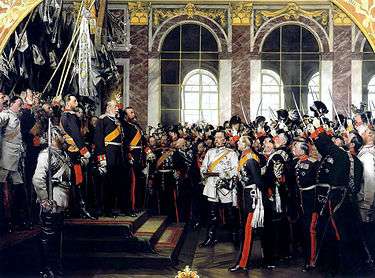
During the first half of the 19th century, many Germans looked forward to a unification of the German states, but most German leaders and the foreign powers were opposed to it. The German nationalist movement believed that a united Germany would replace France as the dominant land power in Western Europe. This argument was aided by demographic changes: since the Middle Ages, France had had the largest population in Western Europe, but in the 19th century, its population stagnated (a trend that continued until the second half of the 20th century), and the population of the German states overtook it and continued to rapidly increase.
Franco-Prussian War
The unification of Germany was triggered by the Franco–Prussian War in 1870 and the French defeat. German forces crushed the French armies at the Battle of Sedan. Finally, the Treaty of Frankfurt, reached after a lengthy siege of Paris forced France to cede the German-speaking Alsace-Lorraine territory (consisting of most of Alsace and a quarter of Lorraine), of which most of the inhabitants spoke German dialects. France had to pay an indemnity of five billion francs to the newly declared German Empire. Thereafter, the German Empire was widely viewed as having replaced France as the leading land power in Europe.
The long-term French reaction was Revanchism: a deep sense of bitterness, hatred and demand for revenge against Germany, especially because of the loss of Alsace and Lorraine.[3][4] Paintings that emphasized the humiliation of the defeat came in high demand, such as those by Alphonse de Neuville. [5]

The World Wars
_(RA)_-_The_Signing_of_Peace_in_the_Hall_of_Mirrors%2C_Versailles%2C_28th_June_1919_-_Google_Art_Project.jpg)
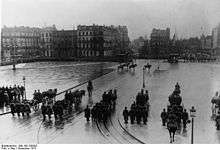
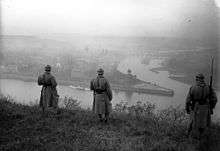
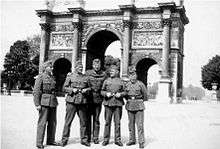

The desire for revenge (esprit de revanche) against Germany, particularly for the recovery of the "lost provinces" of Alsace and Lorraine (whose importance was summed up by the French politician Léon Gambetta in the phrase: "Never speak of them; never forget them!") remained strong in France over the next 50 years and was the key French war aim in World War I. The Allied victory saw France regain Alsace-Lorraine and briefly resume its old position as the leading land power on the European continent. France was the leading proponent of harsh peace terms against Germany at the Paris Peace Conference.
As the war had been fought on French soil, it had destroyed much of the infrastructure and industry in Northern France, and France had suffered the highest number of casualties proportionate to population. Much of French opinion wanted the Rhineland; the section of Germany adjoining France and the old focus of French ambition, to be detached from Germany as an independent country. In the end, the Americans and the British forced them to settle for a promise that the Rhineland would be demilitarized, and that heavy German reparation payments would be levied.
On the remote Eastern end of the German Empire, the Memel territory was separated from the rest of East Prussia and occupied by France before being annexed by Lithuania. In response to the German failure to pay reparations under the Treaty of Versailles in 1923, France returned with the Occupation of the Ruhr area of Germany, the center of German coal and steel production, until 1925. Also, the French-dominated International Olympic Committee banned Germany from the Olympic Games of 1920 and 1924, which illustrates the French desire to isolate Germany.
Under terms of Versailles, the French Army had the right to occupy the Rhineland until 1935, but in fact the French withdrew from the Rhineland in June 1930. As a number of the units the French stationed in the Rhineland between December 1918 - June 1930 were recruited from France's African colonies, this promoted a violent campaign against the so-called "Black Horror on the Rhine" as the German government and various grass-roots German groups claimed that the Senegalese units in the French Army were raping white German women on an industrial scale.[6] Numerous German authors likened that France, the "hereditary enemy on the Rhine" had deliberately unleashed the Senegalese-who were always portrayed as animals or malicious children -- to rape German women.[7] In the words of the American historian Daniel Becker, the campaign against the "Black Horror on the Rhine" centered "tales of sexual violence against German, bourgeois, white women that often bordered on the pornographic" and the campaign against the "Black Horror" by various German authors and associated international sympathizers "unleashed a rhetoric of violence, and radical nationalism that, as some scholars have argued, laid the groundwork for widespread support for the various racial projects of the Nazi regime."[8] Additionally, the campaign against the "Black Horror on the Rhine" served to strengthen the demand for Germany to become the Volksgemeinschaft (People's Community") because only by becoming united in the Volksgemeinschaft could Germany again become strong enough to crush France and end the "Black Horror".[9]
However, the UK and the US did not favor these policies, which were seen as too pro-French. Germany soon recovered economically and then from 1933, under Adolf Hitler, began to pursue an aggressive policy in Europe. Meanwhile, France in the 1930s was tired, politically divided, and above all dreaded another war, which the French feared would again be fought on their soil for the third time, and again destroy a large percentage of their young men. France's stagnant population meant that it would find it difficult to withhold the sheer force of numbers of a German invasion; it was estimated Germany could put two men of fighting age in the field for every French soldier. Thus in the 1930s the French, with their British allies, pursued a policy of appeasement of Germany, failing to respond to the remilitarization of the Rhineland, although this put the German army on a larger stretch of the French border.
Finally, however, Hitler pushed France and Britain too far, and they jointly declared war when Germany invaded Poland in September 1939. But France remained exhausted and in no mood for a rerun of 1914–18. There was little enthusiasm and much dread in France at the prospect of actual warfare. After the Phoney War when the Germans launched their blitzkrieg invasion of France in 1940, the French Army crumbled within weeks, and with Britain retreating, an atmosphere of humiliation and defeat swept France.
A new government under Marshal Philippe Pétain called for an armistice, and German forces occupied most of the country. A minority of the French forces escaped abroad and continued the fight under General Charles de Gaulle (the "Free French" or the "Fighting French"). On the other hand, the French Resistance conducted sabotage operations inside German-occupied France. To support the invasion of Normandy of 1944, various groups increased their sabotage and guerrilla attacks; organizations such as the Maquis derailed trains, blew up ammunition depots, and ambushed Germans, for instance at Tulle. The 2nd SS Panzer Division Das Reich came under constant attack and sabotage on their way across the country to Normandy, suspected the village of Oradour-sur-Glane of harboring terrorists, arms and explosives, and wiped out the population in retaliation.
There was also a free French army fighting with the Allies, numbering almost 500,000 men by June 1944, 1,000,000 by December and 1,300,000 by the end of the war. By the war's end, the French army occupied south-western Germany and a part of Austria.
When Allied forces liberated Normandy and Provence in August 1944, a victorious rebellion emerged in occupied Paris and national rejoicing broke out, as did a maelstrom of hatred directed at French people who had collaborated with the Germans (most infamously, the shaving of the heads of French girls who had gone out with German soldiers). Some Germans taken as prisoners were killed by the resistance.
Post-war relations

There was debate among the other Allies as to whether France should share in the occupation of the defeated Germany because of fears that the long Franco–German rivalry might interfere with the rebuilding of Germany. Ultimately the French were allowed to participate and from 1945 to 1955, French troops were stationed in the Rhineland, Baden-Württemberg, and part of Berlin, and these areas were put under a French military governor. The Saar Protectorate was allowed to rejoin West Germany only in 1957.
Kehl was turned into a suburb of Strasbourg. After the war, all citizens were expelled from Kehl. This state continued until 1953, when the city was returned to the Federal Republic of Germany and the refugees returned.
In the 1950s, the French and West Germans launched a new period of Franco–German cooperation that led to the formation of the European Union. Since then, France and Germany (West Germany between 1949 and 1990) have generally cooperated in the running of the European Union and often in foreign-policy matters in general. For example, they jointly opposed the US invasion of Iraq in 2003, leading U.S. Secretary of Defense Donald Rumsfeld to lump them together as "Old Europe."
Chronology
- 843: Treaty of Verdun: division of the Holy Roman Empire of Charlemagne into a Western Franconia realm (foundation of France), a central realm (Lorraine), and an Eastern Franconia realm (foundation of Germany).
- 1214: Battle of Bouvines
- 1250–1300: Philip IV of France's offensive territorial policy against the Holy Roman Empire
- 1477: After the death of Charles I, Duke of Burgundy, the territory of the Duchy of Burgundy was annexed by France. In the same year, Charles' daughter Mary of Burgundy married Archduke Maximilian of Austria, giving the Habsburgs control of the remainder of the Burgundian Inheritance. Although the Duchy of Burgundy itself remained in the hands of France, the Habsburgs remained in control of the other parts of the Burgundian inheritance, notably the Low Countries and the Free County of Burgundy.
- 1618–48: Thirty Years' War
- 1672–78: Franco–Dutch War between the Netherlands and France expands to a European conflict in 1673–74
- 1688: War of the Grand Alliance
- 1688–1702 Esechiel du Mas, Comte de Melac pursues a policy of death and destruction in SW Germany "Brulez le Palatinat", countless cities, towns and villages were reduced to ashes
- 1701–14: War of the Spanish Succession between the Houses of Bourbon and Habsburg
- 1718: War of the Quadruple Alliance
- 1733–35: War of the Polish Succession between the Houses of Bourbon and Habsburg
- 1740–48: War of the Austrian Succession → main antagonists: France and Great Britain
- 1754 and 1756–63: Seven Years' War → Prussia, Great Britain, and Hannover against France, Austria, the Russian Empire, Sweden, and Saxony
- 1792–1815: French Revolutionary Wars
- 1792–97: War of the First Coalition: Prussia and Austria, since 1793 also Great Britain, Spain, the Netherlands, Sardinia, Naples, and Tuscany against French Republic. French occupation of the Rhineland.
- 1794: Holy Roman Empire and France, French occupation of Austrian Netherlands (1795–1806 Batavian Republic)
- 1799–1815: Napoleonic Wars
- 1803–06: War of the Third Coalition: France closes out the Holy Roman Empire.
- 1806–07: War of the Fourth Coalition: Prussia, Electorate of Saxony, Saxony-Weimar, and Brunswick against the French Empire. All Franco–Prussian battles were French victories of Napoleon I (including Battle of Jena–Auerstedt) ensuing this was the occupation of Prussia per the Treaties of Tilsit. Prussia was conquered by France in only 19 days.
- 1813: Battle of the Nations
- 1840: Rhine crisis: Rhine was a historic object of frontier trouble, between France and Germany; in 1840, the Rhine crisis evolved, because the French prime minister, Adolphe Thiers, started to talk about the Rhine border.
- 1848: Revolutions of 1848 grip the German states after French liberalism becomes popular with German peasants.
- 1870–71: Franco–Prussian War. The defeat of Napoleon III led to the unification of Germany in the German Empire under Prussian leadership.
- 1914–18: World War I, mostly fought in trenches in France
- 1923–30: French Occupation of the Ruhr.
- 1939–40: Battle of France. Victory of Hitler over the Allies (France, Great Britain et al). France was conquered by Germany in only 1 month and 12 days.
- 1940–42: North part of metropolitan France is occupied by Germany per the Second Armistice at Compiègne.
- 1942–44: Following the Anglo-American landing in French North Africa, the South part of France is occupied by Germany.
- 1944–45: Following the Allies landing in Normandy and Provence (including Free French forces), a Vichy French exile government is created in western Germany, the Sigmaringen enclave.
- 1945: The defeat of Germany during World War II led to the French occupation of parts of western Germany (and Berlin)
- 1963: Élysée Treaty of friendship between France and West Germany, signed by President Charles de Gaulle and Chancellor Konrad Adenauer
See also
References
- ↑ Julius Weis Friend: The Linchpin: French–German Relations, 1950–1990,
- ↑ René Girard, Achever Clausewitz, Carnets Nord, Paris, 2007
- ↑ Karine Varley, "The Taboos of Defeat: Unmentionable Memories of the Franco-Prussian War in France, 1870–1914." in Jenny Macleod, ed., Defeat and Memory: Cultural Histories of Military Defeat in the Modern Era (Palgrave Macmillan, 2008) pp. 62-80.
- ↑ Karine Varley, Under the Shadow of Defeat: The War of 1870-71 in French Memory (2008)
- ↑ Robert Jay, "Alphonse de Neuville's 'The Spy' and the Legacy of the Franco-Prussian War," Metropolitan Museum Journal (1984) 19: pp. 151-162 in JSTOR
- ↑ Becker, Daniel (September 2009). ""Black Horror" and the "White Race"". H-Net Reviews. Retrieved 2008-05-29.
- ↑ Becker, Daniel (September 2009). ""Black Horror" and the "White Race"". H-Net Reviews. Retrieved 2008-05-29.
- ↑ Becker, Daniel (September 2009). ""Black Horror" and the "White Race"". H-Net Reviews. Retrieved 2008-05-29.
- ↑ Becker, Daniel (September 2009). ""Black Horror" and the "White Race"". H-Net Reviews. Retrieved 2008-05-29.
- Daniel, Ute; Krumeich, Gerd; et al. (2006), Frankreich und Deutschland im Krieg (18.-20. Jahrhundert) : Zur Kulturgeschichte der europäischen "Erbfeindschaft".
Further reading
- Albrecht-Carrié, René. A Diplomatic History of Europe Since the Congress of Vienna (1958), 736pp; basic survey
- Clark, Christopher. The Sleepwalkers: How Europe Went to War in 1914 (2013) excerpt and text search
- Langer, William. An Encyclopedia of World History (5th ed. 1973); highly detailed outline of events
- MacMillan, Margaret. The War That Ended Peace: The Road to 1914 (2013)
- Rich, Norman. Great Power Diplomacy: 1814-1914 (1991), comprehensive survey
- Scheck, Raffael. “Lecture Notes, Germany and Europe, 1871–1945” (2008) full text online, a brief textbook by a leading scholar
- Steiner, Zara. The Triumph of the Dark: European International History, 1933–1939 (Oxford History of Modern Europe) (2011) 1236pp
- Taylor, A.J.P. The Struggle for Mastery in Europe 1848–1918 (1954) 638pp; advanced history and analysis of major diplomacy
- Wetzel, David. A Duel of Giants: Bismarck, Napoleon III, and the Origins of the Franco-Prussian War (2003)
- Young, Robert France and the Origins of the Second World War (1996)
External links
- Aide-mémoire concerning the separation of Germany’s industrial regions (8 September 1945) Franco-German relations. CVCE.eu
- France, Germany and the Struggle for the War-making Natural Resources of the Rhineland
- French–German enmity in the New York Times
- Fäßler, Peter: Der Rhein, Deutschlands Strom, nicht seine Grenze
